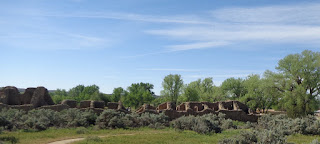Firstly, Aztec has nothing to do with the Aztecs. It is just that this ancient pueblo is remarkably well preserved and when the Spanish first saw it they associated any large stone building with the Aztecs.
I find this the easiest of the ancestral puebloan sites to understand. This may be because only half the site, the western Great House, is excavated the eastern great house remaining to be excavated in the future. Also the buildings have survived reasonably intact and although Earl Morris who excavated the site in the 1920s reconstructed the great kiva and stole some roof beams to build his house (!!!) but 90% of what is there is original. There is a well set out walkway to keep you off the ruins and you actually go through some of the housing.
The site was constructed in just 30 years as a planned community of settlers from Chaco. In the 1920s using modern equipment if took Earl Morris's team 5 months to reconstruct the Great Kiva, using largely material already present on site. To construct the 2 great houses bringing in stone and roof beams in just 30 years without draught animals or any sort of wheel involved a major investment.
The site was entered through an arc of single storey rooms into the Plaza.
The Great Kiva now reconstructed dominates the plaza.
They were public buildings used for religious purposes and bringing together various clans who would each have had their own smaller kiva.
A unique feature of this structure are the 15 rooms encircling the kiva accessible by ladder. The function is unclear. some painted plaster was clinging to the remaining walls so these colours were used in the reconstruction.
Four pillars of alternating masonry and horizontal poles hold up the roof beams and test on huge circles of stone from 30 miles away. There is a central firepit
and 2 vaults.
a second smaller kiva is immediately behind the Great Kiva. It would have been roofed and accessed through a hatchway in the roof.
The unusual T-shaped doors must have had a significance.
Internally a series of doors led from room to room. some items left by the inhabitants can still be seen like a grinding stone similar to those at the Albequerque petroglyph site
and a woven yucca mat covering a doorway and abandoned by its owners 800 years ago.
The roof timbers where large beams of spruce, douglas fir or ponderosa pine support smaller beams or latillas of aspen or pine. For the bigger beams high quality timber from higher latitudes 30 miles to the north was preferred to local timber even though it had to be carried in by hand. The latillas support a layer of thin juniper strips which in turn are covered in tamped earth forming the floor of the storey above.
These are the original ceilings not reconstructions but are identical in construction to traditional pise houses in Southern Morocco.
The Chaco people left and Mesa Verde people moved in for about 50 years but by 1300CE the pueblo was abandoned.


























Very interesting but where are the cars?????
ReplyDelete